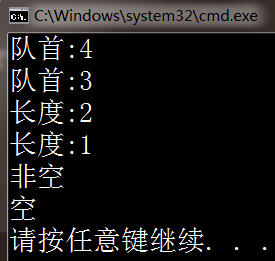版权声明:原创文章,转载请注明出处 https://blog.csdn.net/hza419763578/article/details/88380221
priority_queue 优先队列,只可以访问队首元素top(),只可以pop()队首元素,可以随意push元素。会自动按照优先级排序。对于基本数据类型,按照数值由小到大(从队首到队尾排序)
1.基本方法
#include<iostream>
#include<queue>
using namespace std;
void empty(priority_queue<int> q){
if(q.empty()){
cout<<"空\n";
}else{
cout<<"非空\n";
}
}
int main(){
priority_queue<int> q;
q.push(3);
q.push(4);
q.push(1);
//4 3 2
cout<<"队首:"<<q.top()<<endl;
q.pop();//3 2
cout<<"队首:"<<q.top()<<endl;
cout<<"长度:"<<q.size()<<endl;
q.pop();//2
cout<<"长度:"<<q.size()<<endl;
empty(q);
q.pop();//null
empty(q);
return 0;
}
2.设置优先级别
(1)基本数据类型
这两种方式等价:(默认方式,less表示数字大的优先级大)
priority_queue<int> q;
priority_queue<int,vector<int>,less<int> > q; //优先队列底层是堆,vector<int>就是承载底层的堆的
数字小的优先级大:
priority_queue<int,vector<int>,greater<int> > q;
#include<iostream>
#include<queue>
using namespace std;
int main(){
priority_queue<int,vector<int>,greater<int> > q;
q.push(3);
q.push(4);
q.push(1);
cout<<q.top()<<endl;
return 0;
}
扫描二维码关注公众号,回复:
5501886 查看本文章


3.结构体优先级设置(重载<运算符)
写法1:
#include<iostream>
#include<queue>
using namespace std;
struct fruit{
string name;
int price;
fruit(string name,int price){
this->name=name;
this->price=price;
}
friend bool operator < (fruit f1,fruit f2){
return f1.price<f2.price;//大的优先级高 和sort() cmp相反
}
};
int main(){
priority_queue<fruit> q;
fruit f1=fruit("桃子",3);
fruit f2=fruit("梨子",4);
fruit f3=fruit("苹果",1);
q.push(f1);
q.push(f2);
q.push(f3);
cout<<q.top().name<<" "<<q.top().price<<endl;
return 0;
}
写法2:
#include<iostream>
#include<queue>
using namespace std;
struct fruit{
string name;
int price;
fruit(string name,int price){
this->name=name;
this->price=price;
}
};
struct cmp{
bool operator() (fruit f1,fruit f2){
return f1.price>f2.price;//小的优先级别高
}
};
int main(){ //指定cmp结构体为比较依据
priority_queue<fruit,vector<fruit>,cmp> q;
fruit f1=fruit("桃子",3);
fruit f2=fruit("梨子",4);
fruit f3=fruit("苹果",1);
q.push(f1);
q.push(f2);
q.push(f3);
cout<<q.top().name<<" "<<q.top().price<<endl;
return 0;
}

4.应用
贪心
dijkstra算法优化